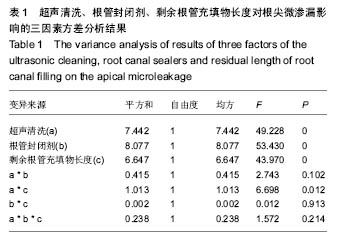| [1]Metzger Z,Abramovitz R,Abramovitz L,et al.Correlation between remaining length of root canal fillings after immediate post space preparation and coronal leakage.J Endod.2000;26(12):724-728.[2]Pappen AF,Bravo M,Gonzalez-Lopez S,et al.An in vitro study of coronal leakage after intraradicular preparation of cast-dowel space.J Prosthet Dent. 2005;94(3):214-218.[3]Abramovitz I,Tagger M,Tamse A,Metzger Z.The effect of immediate vs. delayed post space preparation on the apical seal of a root canal filling: a study in an increased-sensitivity pressure-driven system.J Endod.2000;26(8):435-439.[4]Rahimi S,Shahi S,Nezafati S,et al.In vitro comparison of three different lengths of remaining gutta-percha for establishment of apical seal after post-space preparation.J Oral Sci.2008; 50(4):435-439.[5]Attam K,Talwar S.A laboratory comparison of apical leakage between immediate versus delayed post space preparation in root canals filled with Resilon.Int Endod J.2010;43(9):775-781.[6]Metzger Z,Abramovitz R,Abramovitz L,et al.Correlation between remaining length of root canal fillings after immediate post space preparation and coronal leakage.J Endod. 2000; 26(12):724-728.[7]Mozini AC,Vansan LP,Sousa Neto MD,et al.Influence of the length of remaining root canal filling and post space preparation on the coronal leakage of Enterococcus faecalis. Braz J Microbiol.2009;40(1):174-179.[8]曹小丽,陈碌,李荣华,等.即刻与延迟桩道预备对不同根管充填材料根尖封闭性的影响比较[J].河北医药,2013,35(7):994-995.[9]Zmener O,Pameijer CH,Alvarez Serrano S.Effect of immediate and delayed post space preparation on coronal bacterial microleakage in teeth obturated with a methacrylate- based sealer with and without accelerator.Am J Dent. 2010; 23(2):116-120.[10]Dhaded N,Uppin VM,Dhaded S,et al.Evaluation of immediate and delayed post space preparation on sealing ability of Resilon-Epiphany and Gutta percha-AH plus sealer.J Conserv Dent. 2013;16(6):514-517.[11]Fan B,Wu MK,Wesselink PR.Leakage along warm gutta-percha fillings in the apical canals of curved roots. Endod Dent Traumatol.2000;16(1):29-33.[12]郭可武,张保卫.自粘接型树脂水门汀的研究进展[J].口腔材料器杂志,2011,20(2):92-94.[13]Monticelli F,Osorio R,Mazzitelli C,et al.Limited decalcification/diffusion of self-adhesive cements into dentin.J Dent Res.2008;87(10):974-979.[14]Pavan S,dos Santos PH,Berger S,et al.The effect of dentin pretreatment on the microtensile bond strength of self-adhesive resin cements.J Prosthet Dent. 2010;104(4): 258-264.[15]Naumann M,Blankenstein F,Dietrich T.Survival of glass fibre reinforced composite post restorations after 2 years-an observational clinical study.J Dent.2005; 33(4):305-312.[16]冯新颜,高承志.栓道预处理对自粘接树脂水门汀粘接纤维桩粘接强度的影响[J].中国组织工程研究,2016,20(47):7083-7089.[17]王霜剑,唐旭炎.根管内不同预处理对玻璃纤维桩粘接强度的影响[J].安徽医学,2015,36(8):920-923.[18]李萌,李晓静,周唯,等.桩道酸蚀处理对自粘接树脂水门汀与纤维桩粘接性能影响的研究[J].临床口腔医学杂志,2015,31(3):165-168.[19]廖娟,费伟,郭俊,等.不同激光预处理对纤维桩与牙本质粘结强度影响的体外研究[J].激光杂志,2014,35(11):127-128.[20]Lo Giudice G,Lizio A,Giudice RL,et al.The Effect of Different Cleaning Protocols on Post Space: A SEM Study.Int J Dent. 2016;2016:1907124.[21]Coniglio I,Magni E,Goracci C,et al.Post space cleaning using a new nickel titanium endodontic drill combined with different cleaning regimens.J Endod. 2008;34(1):83-86. [22]祝书金,刘翠玲,郑政,等.不同根封闭剂及清洗方法对纤维桩粘接强度的影响[J].华西口腔医学杂志,2015,33(3):311-314.[23]常颖,王学玲,王维丽,等.桩道牙本质壁的不同处理对纤维桩粘接强度的影响[J].口腔颌面修复学杂志,2015,16(3):169-173.[24]唐颖,蔡展文,董聪.超声根管清洗术对纤维桩粘接固位力的影响[J].口腔材料器械杂志, 2014, 23(1); 20-34.[25]马江敏,朱苑.超声技术提高根管冲洗效果的研究进展[J].实用医药杂志,2014, 31(12):1129-1131.[26]Langeland K,Liao K,Pascon EA.Work-saving devices in endodontics: efficacy of sonic and ultrasonic techniques.J Endod.1985;11(11):499-510.[27]Ahmad M,Pitt Ford TJ,Crum LA.Ultrasonic debridement of root canals: acoustic streaming and its possible role.J Endod.1987;13(10):490-499.[28]Robertson D,Leeb IJ,McKee M,et al.A clearing technique for the study of root canal systems.J Endod.1980;6(1):421-424.[29]王芬,薛明.根管封闭剂研究进展[J].中国实用口腔科杂志,2013, 6(4):246-249.[30]Schäfer E,Olthoff G.Effect of three different sealers on the sealing ability of both thermafil obturators and cold laterally compacted Gutta-Percha.J Endod. 2002;28(9):638-642.[31]Kokkas AB,Boutsioukis ACh,Vassiliadis LP, et al.The influence of the smear layer on dentinal tubule penetration depth by three different root canal sealers: an in vitro study.J Endod.2004;30(2):100-102.[32]李红文,耿发云,曾宪涛,等.三种根管封闭剂根管封闭性能的实验研究[J].临床口腔医学杂志,2013,29(2):103-105.[33]Ørstavik D,Nordahl I,Tibballs JE. Dimensional change following setting of root canal sealer materials.Dent Mater. 2001;17(6):512-519.[34]Inan U,Aydemir H,Ta?demir T.Leakage evaluation of three different root canal obturation techniques using electrochemical evaluation and dye penetration evaluation methods.Aust Endod J.2007;33(1):18-22.[35]安雪银,王成坤,陈路.微渗漏发生原因及其常用检测方法的研究进展[J].吉林大学学报:医学版,2013,39(6):1307-1310.[36]Ahlberg KM,Assavanop P,Tay WM.A comparison of the apical dye penetration patterns shown by methylene blue and india ink in root-filled teeth.Int Endod J.1995;28(1):30-34.[37]Schäfer E,Olthoff G.Effect of three different sealers on the sealing ability of both thermafil obturators and cold laterally compacted Gutta-Percha.J Endod.2002;28(9):638-642.[38]Chong BS,Pitt Ford TR,Watson TF,et al.Sealing ability of potential retrograde root filling materials.Endod Dent Traumatol.1995;11(6):264-269.[39]陈梅,冯云枝.桩道预备及桩核修复对根尖封闭性的影响[J].华西口腔医学杂志,2009,27(5):512-515.[40]肖月,田沁园,刘洋,等.桩道预备后对不同根充方法和根管封闭剂下根尖区微渗漏的对比研究[J].全科口腔医学杂志, 2016,3(2):92-94.[41]杨勤,童方丽,杨明,梁彩英,等.根管封闭剂iRoot SP对椭圆形根管根尖封闭性能的评价[J].实用医学杂志,2016,32(14):2309- 2312. |
.jpg)

.jpg)
.jpg)